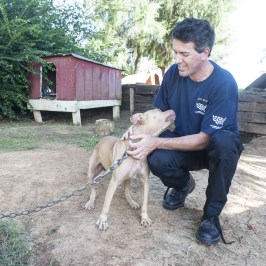
Cover image of The Humane Economy: How Innovators and Enlightened Consumers are Transforming the Lives of Animals.
Wayne Pacelle is the CEO and President of The Humane Society of the United States (HSUS). In his book, “The Humane Economy,” he advances an approach to protecting animals around the world and shows companies how to earn or save money while changing the world.
“This freshly turned economic soil nurtures legions of hungry entrepreneurs who are imagining ways to produce goods and services that do less or no harm to animals. These visionary entrepreneurs are enlisting scientists, economists, engineers, designers, architects, and marketers to the cause of providing food, clothing, shelter, healthcare, research techniques, and even entertainment, without leaving a trail of animal victims behind.”
“The Humane Economy” covers a variety of topics under the umbrella of animal rights and the economy. Some of the topics covered in his book include dogfighting, puppy mills, caged chickens, SeaWorld, and Walmart.
The following is an interview with Pacelle.
Q: How did the concept of “The Humane Economy” come about?
It was the final chapter of “The Bond.” (Pacelle’s first book, “The Bond: Our Kinship with Animals, Our Call to Defend Them”). At that time, I recognized that doing the right moral thing for animals, usually offered the right economic outcome too. That idea began to gain even more traction with me as our societal attitudes toward animals have steadily moved toward more empathy and awareness. Now, it’s clear to me that any business with animal cruelty baked into the business model is taking on unnecessary risk.
“[Petco and PetSmart] threw open their doors to local rescue groups and shelters, giving them access to the foot traffic in their stores. PetSmart and Petco don’t make a dime on the adoption transactions – the fees go directly to the shelters and rescue groups.”
Q: I really like the idea of pet stores showcasing animals from the local shelter for adoption (In Michigan, the news features a homeless pet every day). Is there a way to make sure the pet stores are not hiking up the prices of the pets? Is it even possible to govern such a watch?
Pet stores that sell puppy mill dogs typically offer them up at inordinately high rates – with the price far higher than the adoption fees you’d see for animals made available through animal shelters or rescue organizations. This is an example of the marketplace being upside down: Consumers pay more for poorly treated dogs with proprietors who cut corners, in terms of humane treatment, socialization, and medical care. On the other hand, shelters and rescues do a tremendous amount of legwork to prepare a homeless animal for adoption. The animal you can acquire has almost certainly been spayed or neutered and vaccinated. He or she has also had the benefit of behavior training work. Of course, the other element of the equation is that any person who chooses adoption not only gets a new dog – but also saves a life.
In “The Humane Economy,” Pacelle shares a personal story of his day in Alabama, taking down dogfighting rings. The HSUS officials and volunteers rescued dogs while members of law enforcement agencies arrested the people who kept the dogs. On that day, 367 dogs were rescued from the 10 suspected abusers.
Q: How are HSUS teams trained to handle abused and neglected animals that react to their rescue in a hostile manner? This includes dogs used for dogfighting.
They are experienced animal handlers.
Q: How will you eradicate dogfighting in 120 countries?
It’s an immense challenge, but we’ll be placing staff or consultants in nations throughout the world. They’ll all be moving toward the same goal: Establishing a legal framework against animal cruelty. We’ve already had some great successes, with Bangladesh and several Central American countries, adopting anti-cruelty legislation. When we succeed, these laws will collectively constitute a bulwark for a civil society.
Q: What was the outcome of the puppy mill owners’ lawsuit against The HSUS?
I don’t think we’ve lost one yet.
Q: Where are puppy mills still legal?
It’s legal everywhere to breed dogs, but two-thirds of the states have some standards for breeding. There are also some federal standards. The problem is those standards are not strict enough and puppy mills continue to operate.
Q: When you are reaching out to people, such as Bob Langert (onetime McDonald’s VP for sustainability), how are you able to push through and ahead of other causes that are vying for attention?
We have a talented staff and I think that’s key. We also have a big constituency and that gets the attention of these companies. And finally, it’s obvious to me that animal welfare is one of the paramount concerns for consumers and that goes a long way.
Q: How does The HSUS plan and strategize for a campaign?
We have the best advocates in the field, and we have people who can take-on a problem from many angles – lobbying, litigation, undercover investigations, communications, etc. We bring great experience to the challenges.
In 2000, Chipotle made a name for itself as the “fast-food company with a conscious.” Steve Ells, the founder of Chipotle, was surprised when he learned that many pig farms keep the animals in pens too small for them to even turn around. Ells decided that his restaurant would only purchase products from free-range farms. Chipotle has posted multiple viral YouTube videos speaking out against factory farming. These videos have brought the issue into the public eye.
Q: It must be said that Chipotle’s “Food with Integrity” is powerful and fearless.
Chipotle showed real leadership in the food retail sector and changed the perceptions of the humane economy.
Q: Why did Marcus Rust invite you to the Rose Acre Farms Headquarters to announce the changes that he intended to make? Would it not have been easier for him tell you over the phone, or for him to simply do it?
I think he wanted me to see the very specific things he’d done. A lot of farmers are honored when you come to their farm and see their operation.
Q: How do you build trusting relationships with people you know harm animals?
When it comes to animals, we are all sinners. Animal exploitation is all around us and we are witting or unwitting participants, in so many enterprises. Every one of us is on a journey. The goal of animal protection is to build awareness and to drive changes in behavior. It’s self-defeating if you don’t try to change the people who are hurting animals.
Q: How did you help Rembrandt CEO, Dave Rettig, gain consumers?
So many food retailers that we’ve worked with want cage-free eggs, and if he’s going to produce them it’s a good union.
The HSUS, with the help of some powerful supporters, such as Carl Icahn, were able to persuade companies to change their animal welfare policies. Some of these companies include Walmart, McDonald’s, Smithfield Foods, Armani, and Denny’s. Smithfield Foods had 1 million pigs being raised in crates. They are the largest pig farm in the world, and they have agreed to go cage-free. States changed their laws, banning the use of crates on pig farms. The European Union also banned the use of crates.
Walmart did not simply require their suppliers to become cage-free: Policies were created for companies that wanted Walmart to carry their product. These guidelines covered recycling, reduction in packaging, and energy-efficient light bulbs. The corporation even reduced its own greenhouse emissions and energy use. This impressive move paved the way for other companies to follow suit while requiring others to do the same if they wanted Walmart to sell their product.
Q: What is The HSUS’s true reach outside of the United States?
We operate, through Humane Society International, in more than 50 countries.
Q: If a company is sending chickens to slaughter (assuming to sell the meat) what makes the people taking them to slaughter so careless in their treatment in transport?
Animals can endure a lot of punishment and stay alive. People in the industry have learned they can cut corners in proper handling and treatment of animals and still make a profit.
Q: How do obese chickens and turkeys impact the health of those who eat them; if at all?
It mainly affects the health of the birds, causing them chronic pain and suffering. That said, an industry that breeds and grows obese animals, also overcrowd the birds and subjects them to inhumane slaughter.
In 1931, Winston Churchill stated that “Synthetic food will … from the outset be practically indistinguishable from natural products.” He may have been ahead of his time, but he was not wrong. Andras Forgacs, the founder of Modern Meadow, has developed “lab-grown meat.” Working alongside other scientists, Forgacs used a pinhead-sized sample of muscle cells from a boar to create bite-sized pieces of in vitro meat. The lab-grown meat is also becoming popular in the production of leather goods.
A university in the Netherlands made the first hamburger from lab-grown meat and served it to journalists in London, under the direction of Dr. Mark Post. Sergey Brin, co-founder of Google, was the sole investor in Post’s project. Brin said he was uncomfortable with the treatment of livestock and believes in the future. In “The Humane Economy,” he is quoted, “If what you’re doing is not seen by some people as science fiction, it’s probably not transformative enough.”
Chapter 4 of “The Humane Economy,” shares a few accounts of the extreme mistreatment of animals in the entertainment industry. Twenty-seven animals died during the making of “The Hobbit: An Unexpected Journey.” Director Darren Aronofsky learned firsthand how exotic animal trainers treat their animals. He said the monkeys he ordered for “Fountain,” traveled in cages, inside the back of a truck, from Vancouver to Montreal. Aronofsky stated it was painful to see those monkeys in cages.
Clyde, the orangutan in “Every Which Way But Loose,” was reportedly trained by being beaten with a pipe and sprayed with mace. On the set of “Any Which Way You Can,” Clyde’s trainer caught him stealing donuts. The orangutan was taken to the training facility and beaten with an ax handle for 20 minutes. He eventually died of a cerebral hemorrhage. Since Clyde’s death, The American Humane Association (AHA) contracted with the Motion Picture Association of America to oversee the treatment of animals on the set. This earns the movie the tag, “No Animals Were Harmed During the Making of This Movie” in the film credits.
Q: Why were the people from the AHA not held more accountable for the animals on the set during their watch?
AHA has limited authority on the set and no law enforcement power. They have the prerogative to making a fuss and to put public pressure on directors who are not adhering to animal welfare standards.
The movie, “Blackfish” was created to answer the question – Why was a highly trained professional at SeaWorld killed by an orca? It answered that question and raised public awareness to the way SeaWorld treated their entertainers and trainers. The harder SeaWorld tried to debunk the documentary, the more the movie was televised. After their stock plummeted 40 percent in a year, the CEO sold $3 million of his shares, and Southwest Airlines, a SeaWorld sponsor, revoked their partnership. From the release of “Blackfish,” in 2013 through 2015, things only progressed in a downward spiral for SeaWorld.
In April 2015, Joel Manby became SeaWorld’s new CEO. It would be his job to decide the new direction of the national aquarium. Manby was a successful automobile executive before he was hired as the CEO of SeaWorld, and this proved to be their best move. Orca performances ended within a year, and the agreement with the Georgia Aquarium to take captured beluga whales also ended. Pacelle states, in “The Humane Economy,” that the release of dozens of performing whales will be no small feat. However, “human ingenuity moved them from the sea to SeaWorld, and human ingenuity can set them back where they belong.”
Q: How does one know how old an orca is in the wild?
Orcas have some distinctive characteristics, and they may be known as individuals by researchers and other informed observers. The ages we affix to them are typically estimates, unless we actually know of a birthdate for animals.
In June 2015, the director of the U.S. Fish and Wildlife Service announced that chimpanzees were being added to the endangered species list. Pacelle quotes Jane Goodall in his book: “This change shows that many people are finally beginning to understand that it is not appropriate to subject our closest relatives to disrespectful, stressful, or harmful procedures, whether as pets, in advertising or other forms of entertainment, or medical research.”
Q: How long has medical science truly been aware that testing on animals gave no real signs of how a person would react to a product?
There’s a long history of drugs tested safely on animals but harming people. I go into some of these cases in “The Humane Economy.”
In April 2010, after the Deepwater Horizon explosion, Pacelle went to Louisiana to help Sen. David Vitter assess the situation of the animals. They wanted to witness the containment of the spill, as well as the animals being rescued and cleaned, to make sure the livelihood of the effected animals was a priority. Absorbent booms were placed and replaced around the shores. Workers were bathing pelicans in Dawn dish detergent and then taking them to wildlife rehabilitation centers. Commercial chemicals broke down the crude oil in the ocean.
Pacelle and Sen. Vitter were concerned about the long-term effects these chemicals would have on the wildlife and the ecosystem.
Q: Has it been determined if the chemicals used to clean up the oil spill are harmful to marine life?
There are a variety of products in use, and 21st-century testing methods can give us a sense of relative risk.
Q: What types of “rare circumstances” would have to occur for the government to allow animal testing?
Under the new law passed for chemicals, the government and industry will be working out more details on this. There will be a lot more spade work on this before we get all the details. Essentially, non-animal testing methods must be tried first and if they do not give us adequate information, only then, can animal testing be used.
Q: Has China changed how the government feels about animal-tested cosmetics?
China had required in-country animal testing for cosmetics sold there. The country has retreated from that rigid and unacceptable standard but China is still a-ways-away from the EU and other countries that forbid animal testing for cosmetics.
Q: I understand that setting Ethiopia’s ivory on fire was a great show against poaching. However, would it have made more sense to build a monument or some limited items?
African nations are burning ivory as a public relations effort to bring awareness to the ivory trade. It is very dramatic and reminds people the ivory is worth more set-in living tissue than extracted from dead elephants.
Q: Why do people see the outrage in other’s actions but not their own?
Our human relationship with animals is fraught with contradictions. We are working to build awareness so that people can align their beliefs with their behavior.
Q: Do the antibiotics that are given to the animals people eat contribute to antibiotic resistant diseases in humans?
Yes, they do. That’s why so many major medical organizations, including the American Medical Association, support federal legislation to end non-therapeutic uses of antibiotics.
Q: Why do you believe the “terrible injustices” America has endured were a necessary part of our tradition?
I don’t think they were necessary, but our response to these injustices was necessary. To conform to our ideals, we had to confront great moral problems, like slavery and child labor. We had to address core defects in democratic decision-making, such as the disenfranchising of women.
Pacelle wants people to understand that animal protection is an urgent moral question that commands the attention of all thinking persons. “For every human-wildlife conflict, too, there’s a business opportunity to resourceful entrepreneurs. Imagine the economic potential for businesses able to humanely control rats in cities, feral pigs in rural areas, and birds like starlings everywhere – in each case preventing problems before they’re out of control and mass killings seem like the only solution.”
By Jeanette Smith
Sources:
The Humane Economy: Book by Wayne Pacelle
Interview: Wayne Pacelle
Featured Image by Kathy Milani Courtesy of HSUS – Used With Permission
Top Image Courtesy of HSUS – Used With Permission





![Adolf Hitler and Donald Trump Similarities Will Lead to What Outcome? [Update]](https://futurepreviews.com/wp-content/uploads/2017/01/Screen-Shot-2017-01-12-at-7.29.12-PM-500x383.png)

